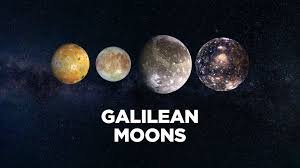The Four Largest Moons of Jupiter: A Celestial Discovery
Jupiter, the largest planet in our solar system, is home to numerous moons. Of these, the four largest—known as the Galilean moons—are Io, Europa, Ganymede, and Callisto. These celestial bodies were first discovered by Galileo Galilei in 1610 and have since been subjects of intense study. They offer a wealth of information about the origins of the solar system, planetary formation, and potentially life beyond Earth.
Io: The Volcanic World
Io is the most volcanically active body in the solar system. It boasts hundreds of volcanoes, some of which can spew plumes of sulfurous gas hundreds of kilometers into space. Its surface is covered with sulfur in different colorful forms, giving it a yellowish-orange appearance. This moon’s proximity to Jupiter subjects it to intense tidal forces, which cause its extreme volcanic activity.
Europa: A Potential Home for Life
Europa, slightly smaller than Earth’s moon, is believed to have a subsurface ocean beneath its icy crust. Scientists consider Europa one of the best candidates in the solar system for the possibility of extraterrestrial life. The presence of water, a key ingredient for life, makes Europa a prime target for future exploration missions, including NASA’s upcoming Europa Clipper mission.
Ganymede: The Largest Moon in the Solar System
Ganymede is not only Jupiter’s largest moon but also the largest moon in the solar system. It is even bigger than the planet Mercury. Ganymede has a magnetic field, which is unique among moons, and is believed to have a saltwater ocean beneath its icy surface. The moon’s surface is a mix of two types of terrain—dark, heavily cratered regions and lighter, less cratered areas—suggesting geological activity in its past.
Callisto: The Ancient Cratered Moon
Callisto is the most heavily cratered object in the solar system, indicating that its surface has remained unchanged for billions of years. Lying furthest from Jupiter among the Galilean moons, it experiences the least gravitational interaction. Callisto’s surface is thought to hide a salty ocean beneath a thick ice layer, but it is considered geologically inactive compared to its counterparts.
Why This News is Important
Exploration of Distant Worlds
The Galilean moons of Jupiter represent some of the most fascinating and potentially habitable bodies in our solar system. Studying these moons offers insights into the evolution of planetary bodies and the possibility of life on other worlds. Missions aimed at exploring these moons could reveal groundbreaking discoveries.
Future Space Missions
With missions like NASA’s Europa Clipper and ESA’s JUICE (JUpiter ICy moons Explorer) planned for the future, there is increasing interest in studying these moons. The findings could be critical for understanding planetary science, with the potential to transform our knowledge of life beyond Earth. As these missions approach, it is crucial to keep the Galilean moons in focus.
Significance in Competitive Exams
For students preparing for government exams, especially those focused on science and space exploration, understanding celestial bodies like the Galilean moons is essential. The topic often appears in general awareness sections, and staying informed about these moons could give students an edge.
Historical Context: Galileo’s Groundbreaking Discovery
In 1610, Galileo Galilei pointed his telescope toward Jupiter and discovered four bright objects surrounding the planet. Initially, he thought they were stars, but upon further observation, he realized they were moons orbiting Jupiter. This discovery was monumental because it challenged the geocentric model of the universe, which placed Earth at the center. Galileo’s observations supported the Copernican model, which posited that planets orbit the sun. These four moons, now called the Galilean moons, marked the beginning of a new era in astronomy and our understanding of the universe.
Key Takeaways from “The Four Largest Moons of Jupiter”
| S.No | Key Takeaway |
|---|---|
| 1 | Io is the most volcanically active body in the solar system. |
| 2 | Europa is a prime candidate for extraterrestrial life due to its subsurface ocean. |
| 3 | Ganymede is the largest moon in the solar system and has a magnetic field. |
| 4 | Callisto’s heavily cratered surface indicates it has been geologically inactive for billions of years. |
| 5 | The Galilean moons were discovered by Galileo in 1610, revolutionizing our understanding of the solar system. |
Important FAQs for Students from this News
1. What are the Galilean moons?
The Galilean moons are the four largest moons of Jupiter discovered by Galileo Galilei in 1610. They are Io, Europa, Ganymede, and Callisto.
2. Why is Io notable among the Galilean moons?
Io is known for its intense volcanic activity. It is the most volcanically active body in the solar system, with hundreds of volcanoes and frequent eruptions.
3. What makes Europa a significant moon for scientific research?
Europa is considered one of the best candidates for finding extraterrestrial life due to its subsurface ocean, which lies beneath a thick layer of ice.
4. What distinguishes Ganymede from other moons?
Ganymede is the largest moon in the solar system and has its own magnetic field. It is even larger than the planet Mercury.
5. What is unique about Callisto?
Callisto has the most heavily cratered surface among the Galilean moons, indicating it has been geologically stable and inactive for billions of years.

